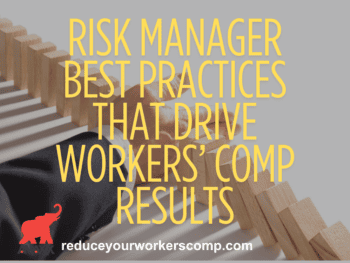To have a successful, effective workers’ compensation program requires commitment from the entire organization, starting at the very top. Leaders must not only endorse the program but be engaged as well, for it to be of value to the company.
A lack of management support will be apparent to the rest of the workforce which won’t share your goals. But there are steps you can take to get leaders to fully embrace your injury management plan.
-
Speak their language
Getting the attention of management is largely a numbers game. Those in the C-suite need to understand the dollars and cents of an effective workers’ compensation program.
Click Link to Access Free PDF Download
-
Play on what is important.
- Find out what matters most. Every organization has some way to determine its financial success. Find out what metric resonates most; the figure management discusses with shareholders, the board of directors or other senior managers. This could be
- EBITDA: The company’s earnings before interest, taxes, depreciation, and amortization. This is the company’s net income with interest, taxes, depreciation, and amortization added back in. It eliminates the effects of financing and accounting decisions. It shows the company’s current operating profitability, or how much profit it makes with its current assets and its operations on the products it produces and sells, as well as providing a proxy for cash flow.
- Net income number. This refers to the profit made after the company subtracts its expenses. Where revenue is the company’s total sales and is known as the top line, net income is called the bottom line, or the company’s earnings.
- Revenue from operations. This is the income generated from an organization’s daily core business operations and is also called operating revenue. It is the revenue posted from selling the company’s products and services.
- Calculate the potential savings. This requires figuring out the cost of a full-time equivalent employee, then determining the possible savings from reductions in workers’ compensation costs. For example, if the important metric is the EBITDA and you know that the cost per FTE over the past three years has been going up, cutting that number in half could potentially reduce the EBITDA number by X percent. You want to use the company’s most important metric to frame the amount of revenue the organization must generate to cover its workers’ compensation losses.
- Define the impact of a claim. Either by your own calculations or through e-mod software.
- Compare the cost of a claim to the expense of something the company wants. Say your company had a recent workers’ compensation claim that cost $575,000 and the company needs certain equipment that costs $500,000. Explain that improvements in your company’s injury management program could have prevented that claim to show the money for the equipment could have been available.
- Produce evidence of wastefulness. Whether it is outright fraud or just a lax attitude toward safety, management responds to pictures and videos of employees that translate to a culture of uncaring about the organization’s resources.
- Present the numbers. A well-run return-to-work program keeps injured workers on the job or gets them back to work quicker. But company leaders may not truly believe that unless you show them real numbers from research:
- Up to 80 percent of lost work days are unnecessary.
- Injured workers out of work and receiving indemnity payments are 4X more likely to have an unsatisfactory outcome. The same research found that employees with similar injuries who either stayed on the job or returned sooner had better outcomes.
- The chances of an injured worker returning to the workforce in any capacity drops by 50 percent after 12 weeks of being out of work.
- Give hiring advice. Management will be more apt to listen to you if you can present a way to avoid hiring the company’s next workers’ compensation claim. An easy, fairly inexpensive way to make sure the right people get hired is through an integrity test, such as the Merchant’s Integrity Test.
FREE DOWNLOAD: “5 Critical Metrics To Measure Workers’ Comp Success”
This is not a personality test nor does it require complex algorithms to interpret the results. The questions are direct and aimed at predicting the likelihood of problem behaviors from the person.
There are 50 questions that have been vetted and updated. According to psychologists who have studied the test, it works because people who engage in ongoing risky behaviors eventually rationalize their behaviors and come to believe there is nothing wrong with their conduct. More than 90 percent of applicants tell the truth about their high-risk behaviors.
Avoiding problem hires is one of the best ways of reducing workers’ compensation costs. Tests from Cornell University and elsewhere have indicated applicants who took and passed the test had half as many workers’ compensation claims as those who did not take it.
Summary
Having an injury management program may sound like a good idea to managers, but to understand its true value to the company requires looking at the numbers. Taking those numbers to management to frame a conversation that is meaningful to the organization can get leaders to be onboard with your program.

Author Michael Stack, CEO Amaxx LLC. He is an expert in workers’ compensation cost containment systems and helps employers reduce their workers’ comp costs by 20% to 50%. He works as a consultant to large and mid-market clients, is a co-author of Your Ultimate Guide To Mastering Workers Comp Costs, a comprehensive step-by-step manual of cost containment strategies based on hands-on field experience, and is founder & lead trainer of Amaxx Workers’ Comp Training Center.
Contact: mstack@reduceyourworkerscomp.com.
Workers’ Comp Roundup Blog: https://blog.reduceyourworkerscomp.com/
©2018 Amaxx LLC. All rights reserved under International Copyright Law.
Do not use this information without independent verification. All state laws vary. You should consult with your insurance broker, attorney, or qualified professional.
FREE DOWNLOAD: “5 Critical Metrics To Measure Workers’ Comp Success”
















